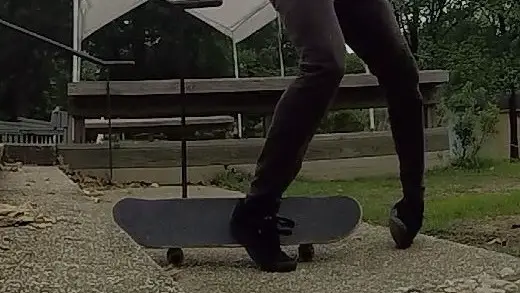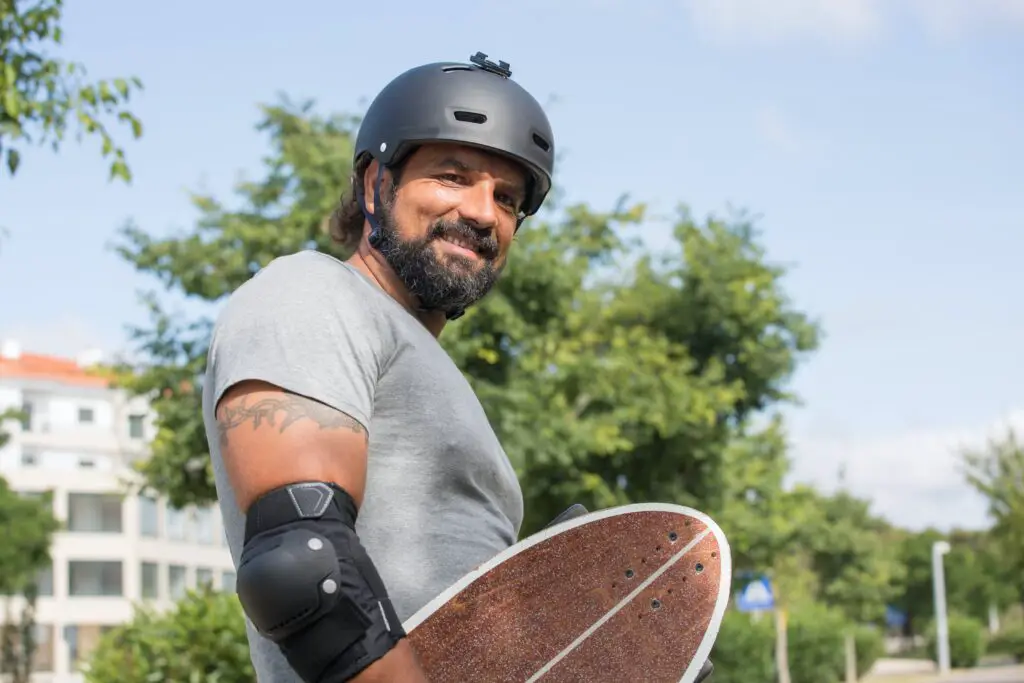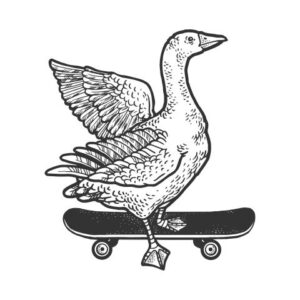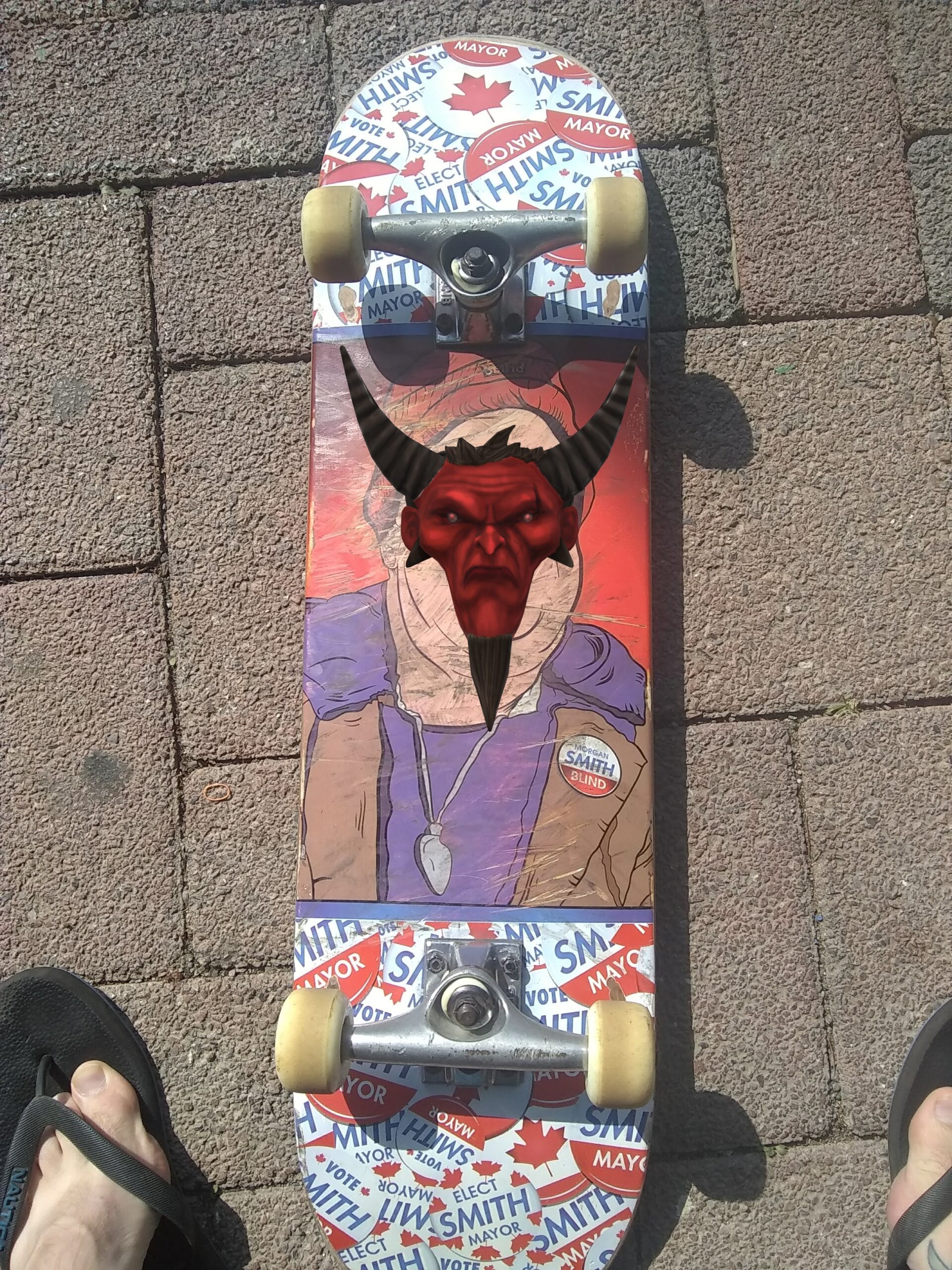Skateboarding has a reputation for being dangerous, reckless, and something that all parents should fear. In reality, it’s not nearly that dangerous if you practice basic safety precautions.
Is Skateboarding Safe?
Personally, I have never hit my head while skating nor have I broken a bone. I have been injured multiple times while skating, the injuries were always mild and were mostly bruises and sprained wrists and ankles.
Skateboarding is a safe hobby if you are wearing safety gear and are skating within your own ability. However, skateboarding does have a high risk of falls and associated minor injuries. Cuts, bruises, and ankle sprains are very common. Major injuries like broken bones or head injuries are much less common and only really happen if you skate large concrete bowls or large street obstacles like stair sets.
Ultimately, skateboarding will be as safe as you want it to be. If you stick to flat ground tricks and wear safety gear then you’ll likely never get injured beyond a few bruises or a scraped knee. However, if you are trying to do tricks off ledges and stairs or skate handrails then you are much more likely to get injured.
Realistically, almost every skater gets injured at some point, but it is mostly just something like a sprained wrist or sprained ankle. Serious injuries are not all that common unless the skater is being genuinely reckless. Head and neck injuries for instance are much more common for longboarders than skateboarders.
That being said, safety precautions are a necessity when going skateboarding. If you want to get a complete breakdown of the safety gear you need to be wearing while skating with sizing charts and costs, check out my full guide.
Skateboarding Health Risks-Common Injuries
Ankle Sprains
Ankles sprains are my least favorite injury that is associated with skateboarding. I have had very nasty ankle sprains before and have had to take months to get back to being healthy.
This relatively minor injury is notoriously persistent and once you sprain your ankle once, it is easier to sprain it again. The sprain itself is actually a tear or stretch in the tendon on your ankle itself. Spraining the tendon actually will stretch it and make it less tight. This is why ankle sprains are a recurring injury and it’s easier to sprain it again.
Usually, you’ll feel a sharp pain and then your ankle will quickly swell up. The swelling depends on how serious it is. At this point, you’ll need to ice and elevate your injury and you can’t skate for at least 2 weeks.
Come back very slowly as your ankle sprain can be reinjured so easily that it can be frustrating. You also don’t want to destroy your ankles for later in life.

Wrist Sprains
Wrist sprains are essentially the same thing as an ankle sprain, but with tendons in your wrists.
These are usually not a big deal and having a sprained wrist won’t stop you from skating. It will just hurt and you should be careful to not hurt again while you’re recovering.
I sprained my wrists often when I fall forward. The only way to protect against them is to either not use your hands at all when you fall or to buy wrist guards. I bought wrist guards.
I’ve never had a wrist sprain swell up significantly, but the injury is annoying as it can be painful. This is an injury that still happens to me from time to time.

Skinned Knees and Elbows
Skinning your knee or elbow refers to falling on concrete and having the top layer of skin removed by the concrete. Any kid who has ridden a bike has skinned his knee at some point.
This is going to happen when you skate, though more likely on your elbow than your knee. This at least has been my experience. I can control my falls enough when falling forward to never fall on my knee, but if I fall backward I can’t control it so end up hitting my elbow.
The way to protect against this is easy. Wear knee pads and elbow pads.
This is especially important for beginners as you will fall often. So suck it up and wear those goofy-looking pads. Your body will thank you.
Cuts and Bruises
Naturally, skateboarding is going to give you some cuts and bruises. Of the two, bruises are much more common. I often get bruises from shinners when my board spins and hits my shins or calves. I get bruises from falls on my legs and butt. I bruise the crap out of the palms of my hands if I don’t wear wrist guards.
Wearing pads will help, but you’re going to get some bruises while skating. The good news is that bruises go away quickly and are not serious injuries.
Cuts happen much less frequently and are usually small and minor. Typically, a cut will come from hitting something at an angle resulting in a sort of hybrid bruise cut. There aren’t so many sharp objects in skateboarding that can cut you outright.
I’ve never had any major cuts from skateboarding.
Broken Bones
Broken bones are perhaps the worst thing that can happen to you while skating.
Breaking bones typically happens from landing improperly and is somewhat rare to happen. I’ve personally never broken a bone. It is also possible to break a bone from a nasty ankle sprain.
There is no real way to protect against broken bones other than to skate within your ability and to learn how to properly fall. Falling improperly while skating a 2-inch curb could break a bone while professionals bail and fall off of huge stairs with no injury all the time.
Skating within your ability also can be tricky sometimes because you need to push yourself to progress. Just push yourself in small ways. Don’t immediately try to ollie stairs once you learn to ollie. Start with a curb.
How to Skateboard Safely
1. Wear Protective Gear
Wearing protective is most important when you are a beginner. You will need a helmet, wrist guards, and maybe knee and elbow pads.
Wearing pads can be the difference between fracturing your elbow or getting up to try the trick again. It can be the difference between a concussion and just a nasty fall.
The more gear you wear, the better protected you are. It can be frustrating seeing the skaters you look up not wear any protective gear at all. I suggest watching skaters like Andy Anderson, Tony Hawk, and Lizzie Armanto. These are skaters who always wear a helmet and sometimes other protective gear. They are also just awesome skaters.
Most skating protective gear is a one-time investment meaning that you buy it once and you’ll never replace it. So invest in your own safety. You’ll be glad you did.

2. Don’t Push Yourself Beyond Your Limits
This is a tricky point.
In order to get better and progress, you need to try new tricks and do things you haven’t done before. Yet, if you go too far outside of your own ability, you’re much more likely to hurt yourself.
Almost all of my nastiest injuries have been from trying to do things that I haven’t tried before in skating. They were beyond my ability at the time and I didn’t yet know it. I was trying to progress too fast.
One example is when I first started skating again. I had just learned to ollie while moving and wanting to start skating down things. So I decided to start with a little 3-set of stairs. I actually sketchily landed it a couple of times before incorrectly stepping off and spraining my ankle worse than I’d ever done before. I should’ve started with a curb, not stairs. It was beyond my ability at the time.
Given some time, you’ll get a much better feel for what is something that you can try and still safely do. For beginners who haven’t developed this sense yet, I can only recommend that you skate and progress cautiously. It’s easy to get impatient.
3. Learn To Fall Properly
Learning to fall properly is the best thing you can do to prevent injuries from skating.
Once you learn how to do this, injuries can and will still happen, but they will be much less frequent and severe. Falling properly involves kicking your board away from your body, falling with your momentum, and spreading out the impact across your body.
Also, avoid falling on hard joints like your knees and elbows as this can lead to a fracture. Never fall onto your own hands or wrists. This could cause a broken bone.
Learning how to fall properly can come easily for people who have played sports before, but can be tricky for some. It is absolutely possible to practice falling safely and you can check out my full guide on how to fall properly here.
Additional Questions
Is Skateboarding Safe For Beginners?
If you are a beginner skater, you should be cautious. When I was first starting to skate I injured myself much more frequently than I do. I sprained and re-sprained my ankles and wrists often. I took hard slams often.
The time when you are most likely to get injured while skating is when you are a beginner. This is because beginners do not yet have good board control, haven’t learned to properly fall, and don’t know what their limits are. Many beginners begin skateboarding only to quickly break their wrist or otherwise injure themselves.
This is why beginners need to be cautious. Wear a helmet and other protective gear. Go slowly and don’t try to progress too fast.
It’s mindboggling how many beginners start, get injured quickly, and then quit skateboarding right after. You need to be realistic about what you don’t know and how easily it is to fall hard onto the concrete. It will take months to get comfortable on your skateboard and caution will get you there faster. Being injured for weeks will not.
Is Skateboarding Safe For Children?
You can find loads of skateboarding children videos on YouTube, Instagram, and TikTok. There is always some little 4-year old strapping up and riding down a small stair set. These are cute to watch, but is skateboarding actually safe for children?
As long as children are wearing safety gear and staying away from large obstacles like concrete bowls, skateboarding is safe for children. Make sure they have a helmet, knee pads, and elbow pads. Children will also need some instruction and guidance on how to skateboard. Do not just leave your kids at the skatepark alone. They might see a more experienced skater and do something dangerous while trying to copy him or her.
The good news is that there are group skate classes for kids in most major cities for a reasonable price. This is a good way for your kids to make friends while skateboarding and to have a professional around to make sure they skate safely.

If you want to see how much a skate lesson or class usually costs, check out my data-driven guide including regional variations.
Is Skateboarding Bad For Your Knees?
Skateboarding can be rough on the body if you do street skating. Especially if you skate ledges, gaps, and stairs. The repeated heavy impact could wreak havoc on your joints if you don’t take proper precautions.
Knees take the majority of an impact force in skateboarding. Many tricks that require an ollie on flat ground can put a lot of stress on the knees. Especially if you are doing a trick off of a ledge or a set of stairs, skateboarding can wear down and even injure your knees. If you have issues with knee pain and injuries, try and focus on transition skating instead of street skating.
Luckily there are skateboarding styles that are much easier on your body such as transition skating. Also, you can wear gear such as skateboarding insoles to lessen the impact that goes to your knees.
If you want a more in-depth look at why you have knee pain after skating with prevention tips, check out my full guide here.
How Dangerous is Skateboarding Compared To Other Sports?
Several studies have found that skateboarding is not particularly dangerous when compared to other sports. The actual rate of injury incidence is low and often low severity. Most serious injuries included an upper limb meaning that you are more likely to break an arm than your leg. (source)
You’re more likely to go to the ER playing basketball than skateboarding according to the United States Consumer Product Safety Commission. Actually, most sports are more dangerous than skateboarding when it comes to injuries that will land you in the hospital. (source)
So research points out that skateboarding is no more dangerous than most other sports you can play. It has a lower ER room incidence rate of injury than most sports so it could actually be considered safer in this regard. You can see the total incidence numbers for 2019 below compared to other sports.
There were almost 150,000 injuries resulting in ER visits in 2019, but skateboarding doesn’t account for the most ER visits by far.
Can Skateboarding Kill You?
Skateboarding’s repupation for being dangerous and bad often precedes it. There is a bad public image of skateboarding being extremely dangerous and how it can even kill skateboarders.
Skateboarding and almost every hobby and activity can kill you. If you wear a helmet and practice safety precautions, you are very unlikely to die from skateboarding. Skateboarding has a lower incidence of injuries that result in ER visits than basketball for example. Research shows that skateboarding is not more dangerous than other sports.
So don’t let that negative image get to you. Research says otherwise. You or your child can skateboard perfectly safely as long as you wear gear and take caution.
Conclusion
So there it is.
Skateboarding isn’t so dangerous if you don’t push yourself too hard and take proper precautions. That being said, you will likely injure yourself at some point. Hopefully, though it will be a minor injury and the longer you skate the less you’ll get hurt.
Hopefully, this article gave you a good idea about the health risks involved with skateboarding. I tried to be as realistic as possible.
Anyway, thanks for reading, and look out for more material from Board and Wheels.



